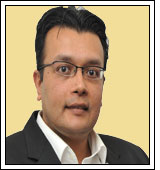 -Surjit Lahiri is Vice President
Projects, Mindteck (India) Ltd
-Surjit Lahiri is Vice President
Projects, Mindteck (India) Ltd
The Smart Grid will
allow utilities to
move electricity
around the system
as efficiently and
economically as
possible.
The basic concept of Smart Grid
is to add monitoring, analysis,
control, and communication
capabilities to the national electrical
delivery system to maximize the
throughput of the system while
reducing the energy consumption.
Smart Grid will allow utilities to
move electricity around the system as
efficiently and economically as
possible.
The global Smart Grid market has
experienced double-digit growth
rates over the last five years and is
expected to continue its growth
momentum. In China, what began as
an effort to supply electricity to most
of the country's population gradually
has shifted focus toward grid
modernization and efficiency. In
Europe, with the EU directive
requiring smart metering technology
by 2020, European utility providers
are quickly assessing Smart Grid and
metering options. There is a demand
for enhancing energy efficiency and
managing demand side management,
as well as integrated renewable and
variable energy sources in the US and
India. The economy in India is
growing at a very fast rate with an
average annual growth rate of over 7
per cent for last couple of years. We
also find that annually the Indian
population is growing at the rate of
1.4 per cent and it is predicted that
India will be the largest populated
country by 2050. Even though
electricity is available to 80 per cent
of the population, it is irregular and
insufficient and the power crisis has
become a chronic problem with an
average 17 power-cuts per month to
the manufacturing sector alone,
which depicts that it is not at all
sufficient for our present needs and
requires enormous investment to
meet the existing and future needs of
the growing population and economy.
The Smart Grid platform will
create a local and global ecosystem of
Smart Grid service providers,
providing products and services at
different layers to energy producers
and consumers alike – commoditizing
and democratizing the tools for
creating and consuming energy
optimally. Energy consumers in
Smart Grid ecosystem will be
generating energy on their own and
freely trading it based on demand and
supply; they will be smartly
consuming optimum energy at the
right time for the right price using
smart appliances. Smart Grid
implementation benefits end
consumers through improved
national security, better
environmental conditions and
economic growth.
The “smartening” of the
electricity system is an evolutionary
process, not a one-time event.
Implementing Smart Grid
technologies in rural areas currently
have economic and technological
challenges which are yet to be
overcome. But opportunities for
renewable energy generation and
integration via microgrids are
immense and have an enormous
potential for income generation and
development of new economy for the
rural community at large.
Government incentives would be a
key catalyst in augmenting the
growth and adoption of Smart Grid
technologies.
 SMART ENERGY
TECHNOLOGY ENABLEMENT
SMART ENERGY
TECHNOLOGY ENABLEMENT
Smart Grid technologies provide
omni-directional communications
between producer and
consumer+application related IT.
Spurred by growing energy demand,
increasing costs and climate change
Smart Grid initiatives are gaining
traction across the country. And
essentially there is a need for utilities
to manage energy load control and
demand response to reduce the
demand for new power plants which is
enabling homeowners and utility companies to work together for
reducing energy consumption, save
money and better grid management.
The key enabling technology for
energy management products in the
home is ZigBee, an ultra low-power
IEEE 802.15.4-based wireless
networking standard that has
emerged as the key to robust, reliable
and secure HAN deployments.
ZigBee has been developed to meet the
growing demand for capable wireless
networking between numerous lowpower
devices. ZigBee is being used for
next generation automated
manufacturing, with small transmitters
in every device on the floor, allowing for
communication between devices to a
central computer. This new level of
communication permits finely-tuned
remote monitoring and manipulation. In
the consumer market ZigBee is being
explored for everything from linking lowpower
household devices such as smoke
alarms to a central housing control unit,
to centralized light controls.
Due to its low power output, ZigBee
devices can sustain themselves on a
small battery for many months, or even
years, making them ideal for installand-
forget purposes, such as most small
household systems. In comparison to
other home networking technologies
ZigBee technology can be easily
incorporated into a wide range of
devices. ZigBee is highly scalable,
capable of supporting thousands of
devices in a single network, and is
extremely tolerant to interference from
other radio devices, including Wi-Fi
and Bluetooth.
Mindteck’s Smart Energy Vertical is
focused on building and deploying
scalable go-to-market Smart Grid
solutions targeted at energy
management and energy efficiency
improvement.